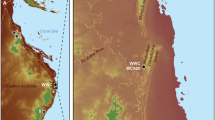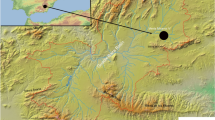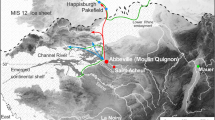Abstract
No detailed explanation has yet been provided for the origin of sarsens (silicified Cenozoic sediments) which are widely distributed across southern England (Fig. 1). The problem of sarsen formation is related to that of analogous terrestrial siliceous deposits recorded from every continent except Antarctica1–7. In addition sarsens are of considerable archaeological interest as they were extensively used in the construction of megalithic monuments, notably those at Avebury and Stonehenge. It has been suggested that sarsens are glacially traitsported erratics8,9, although this view has been challenged10. Their occurrence in areas in which other evidence of glacial activity is lacking, and the preservation on the surface of some sarsen stones of pockets of very weakly cemented sand, does not concur with the idea of long-distance transportation, but rather suggests local derivation from an original Cenozoic cover. Here the initial formation of sarsens is considered and recognition that they represent silcrete remnants enables broad conclusions to be drawn about their genesis and palaeoenvironmaental significance. From macromorphological, micromorphological and chemical comparisons with low latitude sileretes, primarily from southern Africa, it is concluded that sarsens represent remnants of surface and near-surface silicification developed on technically stable landsurf aces of minimal local reitet. Most sarsens seem to have formed under a semi-arid or arid climate, although there is evidence of development in a relatively humid environment for some occurrences.
This is a preview of subscription content, access via your institution
Access options
Subscribe to this journal
Receive 51 print issues and online access
$199.00 per year
only $3.90 per issue
Buy this article
- Purchase on Springer Link
- Instant access to full article PDF
Prices may be subject to local taxes which are calculated during checkout
Similar content being viewed by others
References
Smale, D. J. sedim. Petrol. 43, 1077–1089 (1973).
Dewolf, Y. Bull. Ass. Géogr. fr. No. 424–425, 141–147 (1975).
Langford-Smith, T. (ed.) Silcrete in Australia (University of New England, Armidale, 1978).
Thiry, M. Bull. Bur. Rech. Géol. Min. Ser. 2, Sect. 2, No. 1, 19–46. (1978).
Dury, G. H. & Habermann, G. M. in Silcrete in Australia (ed. Landford-Smith, T.) 223–259 (University of New England, Armidale, 1978).
Fersmann, A. & Wlodawetz, N. C.r. Acad. Sci. l'U.S.S.R. Aug. 145–148 (1926).
King, L. C. The Morphology of the Earth 2nd edn (Oliver and Boyd, Edinburgh, 1967).
Kellaway, G. A. Nature 233, 30–35 (1971).
Kellaway, G. A., Redding, J. H., Shephard-Thorn, E. R. & Destombes, J-P. Phil. Trans. R. Soc. A279, 189–218 (1975).
Green, C. P. Nature 243, 214–216 (1973).
Clark, M. J., Lewin, J. & Small, R. J. Southampton Res. Ser. Geogr. 4, 3–40 (1967).
Kerr, M. H. Proc. Leeds phil. lit. Soc. (Scientific Sect.) 6, 328–337 (1955).
Summerfield, M. A. & Goudie, A. S. Trans. Inst. Br. Geogr. (in the press).
Cecil, C. B. & Heald, M. T. J. sedim. Petrol. 41, 582–584 (1971).
Heald, M. T. & Larese, R. E. J. sedim. Petrol. 44, 1269–1274 (1974).
Millot, G. Geology of Clays (Springer, New York, 1970).
Watts, S. H. Geochim. cosmochim. Acta 41, 1164–1167 (1977).
Author information
Authors and Affiliations
Rights and permissions
About this article
Cite this article
Summerfield, M. Origin and palaeoenvironmental interpretation of sarsens. Nature 281, 137–139 (1979). https://doi.org/10.1038/281137a0
Received:
Accepted:
Issue Date:
DOI: https://doi.org/10.1038/281137a0
Comments
By submitting a comment you agree to abide by our Terms and Community Guidelines. If you find something abusive or that does not comply with our terms or guidelines please flag it as inappropriate.



